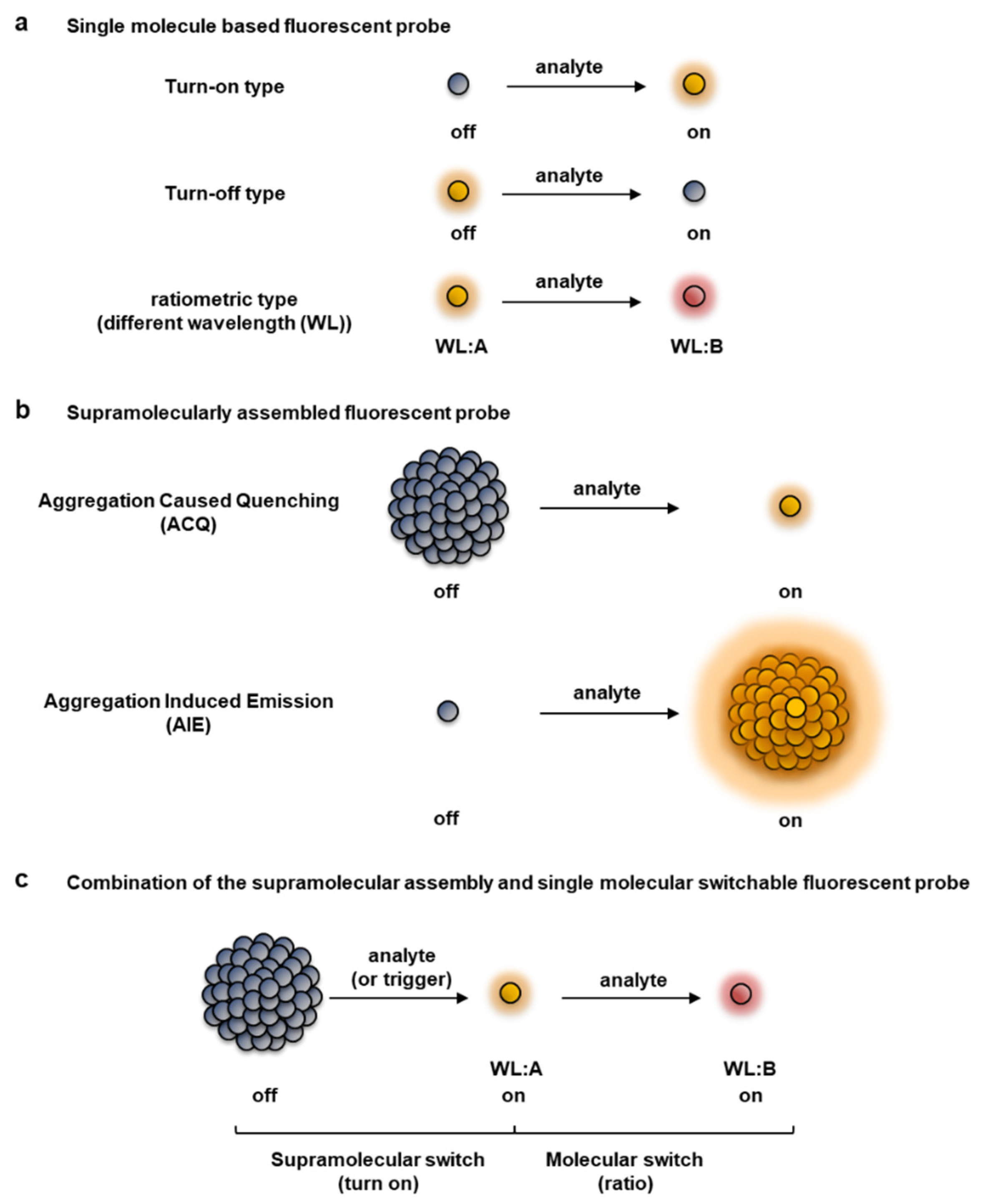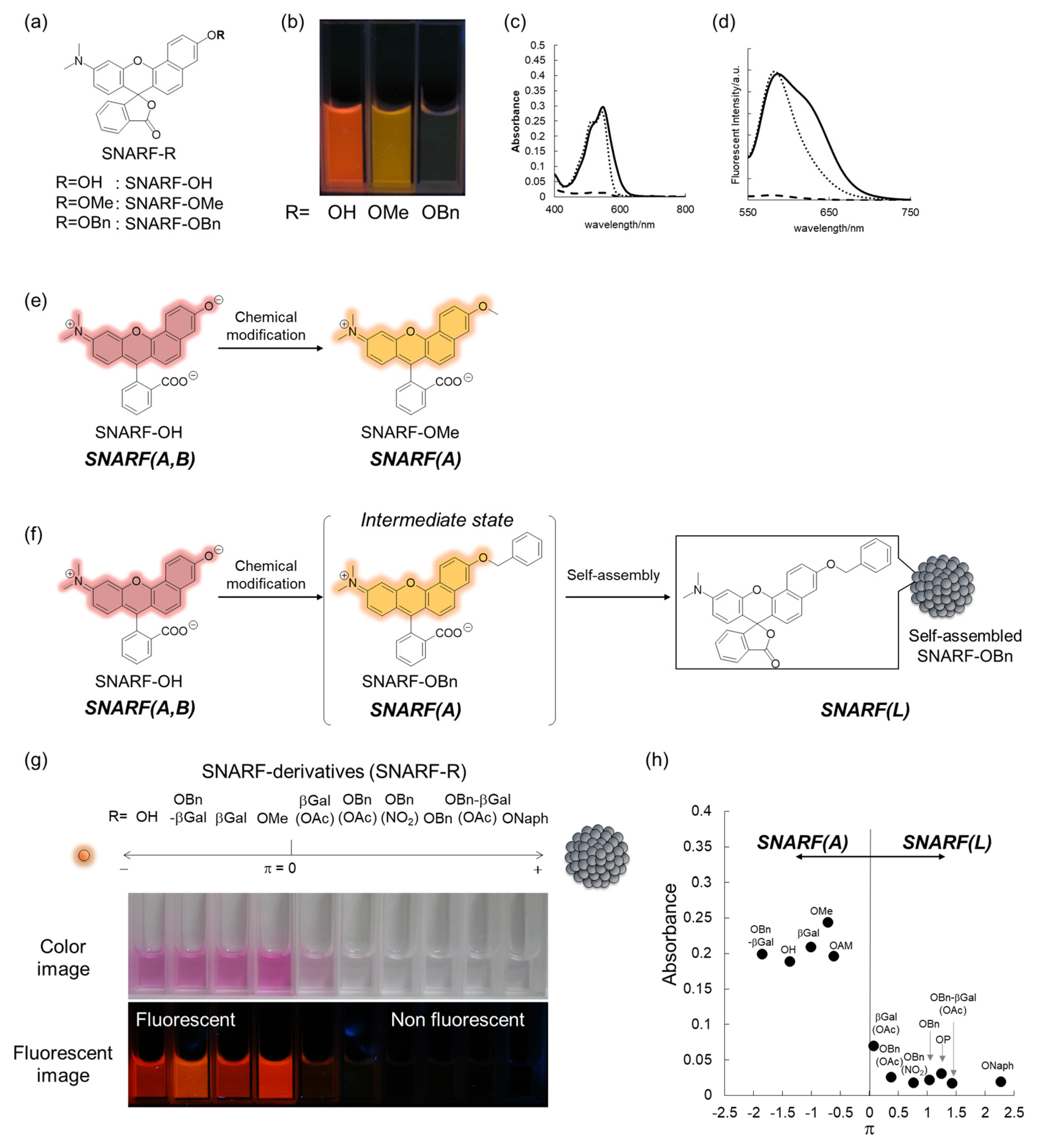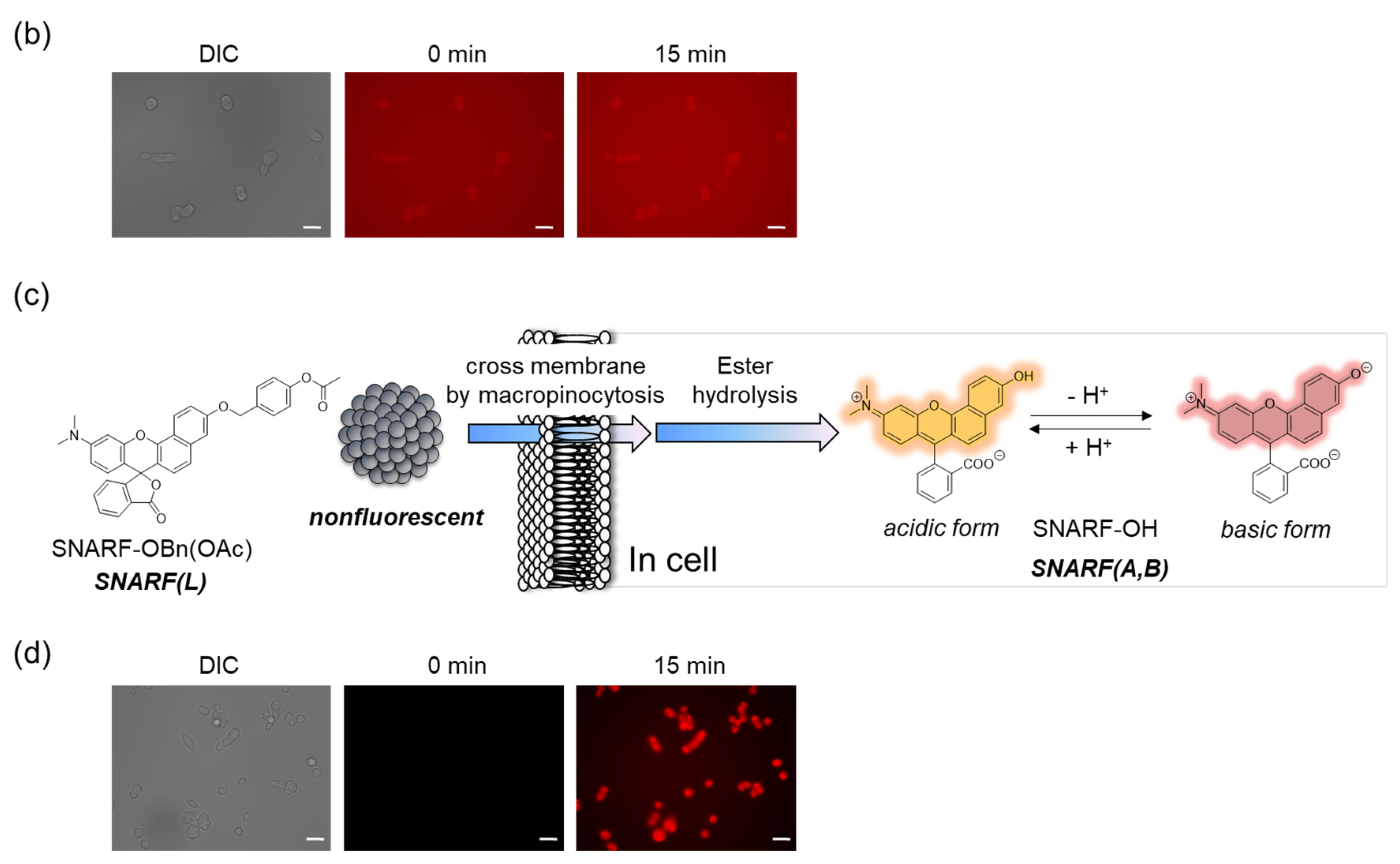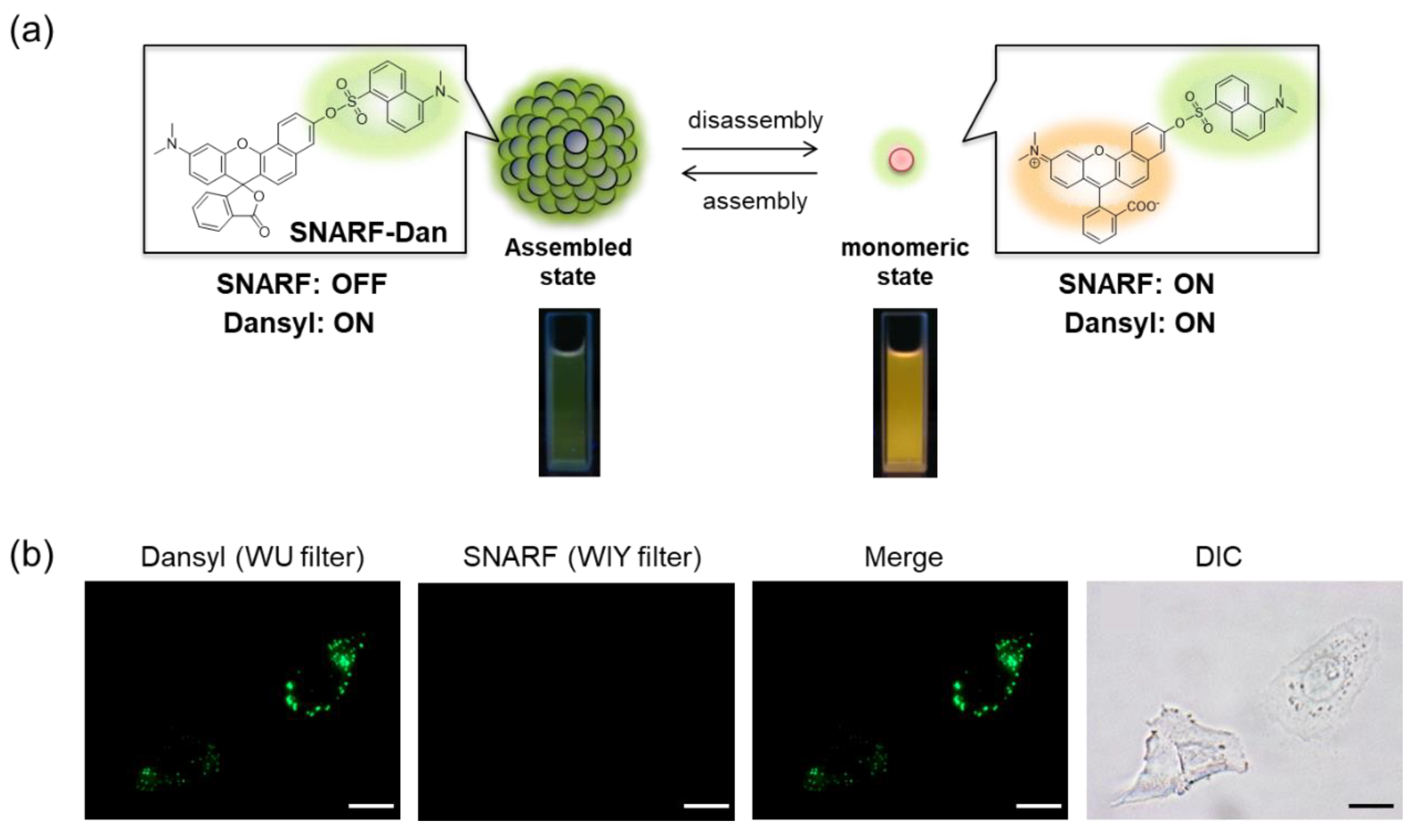Stimuli-Responsible SNARF Derivatives as a Latent Ratiometric Fluorescent Probe
Abstract
1. Introduction
2. Design Strategy of a Ratiometric Fluorescent Probe
2.1. SNARF as the Scaffold of a Ratiometric Fluorescent Probe
2.2. Classical Design of a Ratiometric Fluorescent Probe Based on a SNARF Scaffold
2.3. Design Principle of a Self-Assembled Fluorophore Based on a SNARF Scaffold as a Latent Ratiometric Fluorescent Probe
3. Advantage of a Latent Ratiometric Fluorescent Probe for Intracellular Monitoring
4. Conclusions
Author Contributions
Funding
Institutional Review Board Statement
Informed Consent Statement
Data Availability Statement
Conflicts of Interest
References
- Lavis, L.; Rains, R.T. Bright ideas for chemical biology. ACS Chem. Biol. 2008, 3, 142. [Google Scholar] [CrossRef] [PubMed]
- Kobayashi, M.; Ogawa, R.; Alford, P.; Choyke, L.; Urano, Y. New strategies for fluorescent probe design in medical diagnostic imaging. Chem. Rev. 2010, 110, 2620. [Google Scholar] [CrossRef] [PubMed]
- Ueno, T.; Nagano, T. Fluorescent probes for sensing and imaging. Nat. Methods. 2011, 8, 642. [Google Scholar] [CrossRef]
- Chan, J.; Dodani, S.C.; Chang, C.J. Reaction-based small-molecule fluorescent probes for chemoselective bioimaging. Nat. Chem. 2012, 4, 973. [Google Scholar] [CrossRef] [PubMed]
- Terai, T.; Nagano, T. Small-molecule fluorophores and fluorescent probes for bioimaging. Pflügers Archiv.-Eur. J. Physiol. 2013, 465, 347. [Google Scholar] [CrossRef]
- Aron, A.T.; Ramos-Torres, K.M.; Cotruvo, J.A., Jr.; Chang, C.J. Recognition- and reactivity-based fluorescent probes for studying transition metal signaling in living systems. Acc. Chem. Res. 2015, 48, 2434. [Google Scholar] [CrossRef] [PubMed]
- Kikuchi, K.; Takakusa, H.; Nagano, T. Recent Advances in the Design of Small Molecule-Based FRET Sensors for Cell Biology. TrAC Trends Anal. Chem. 2004, 23, 407. [Google Scholar] [CrossRef]
- Demchenko, A.P. Optimization of fluorescence response in the design of molecular biosensors. Anal. Biochem. 2005, 343, 1. [Google Scholar] [CrossRef]
- Johnsson, N.; Johnsson, K. Chemical tools for biomolecular imaging. ACS Chem. Biol. 2007, 2, 31. [Google Scholar] [CrossRef] [PubMed]
- Wang, H.; Nakata, E.; Hamachi, I. Recent progress in strategies for the creation of protein-based fluorescent biosensors. ChemBioChem 2009, 10, 2560. [Google Scholar] [CrossRef]
- Doussineau, T.; Schultz, A.; Fernandez, A.L.; Moro, A.; Korsten, S.; Trupp, S.; Mohr, G.J. On the design of fluorescent ratiometric nanosensors. Chem.-Eur. J. 2010, 16, 10290. [Google Scholar] [CrossRef] [PubMed]
- Demchenko, A.P. The concept of λ-ratiometry in fluorescence sensing and imaging. J. Fluoresc. 2010, 20, 1099. [Google Scholar] [CrossRef] [PubMed]
- Yuan, L.; Lin, W.; Zheng, L.; Zhu, S. FRET-based small-molecule fluorescent probes: Rational design and bioimaging applications. Acc. Chem. Res. 2013, 46, 1462. [Google Scholar] [CrossRef] [PubMed]
- Huang, X.; Song, J.; Yung, B.C.; Huang, X.; Xiong, Y.; Chen, X. Ratiometric optical nanoprobes enable accurate molecular detection and imaging. Chem. Soc. Rev. 2018, 47, 2873. [Google Scholar] [CrossRef] [PubMed]
- Lavis, L.D. Teaching Old Dyes New Tricks: Biological Probes Built from Fluoresceins and Rhodamines. Annu. Rev. Biochem. 2017, 86, 825. [Google Scholar] [CrossRef]
- Briks, J.B. Photophysics of Aromatic Molecules; Wiley: London, UK, 1970; p. 718. [Google Scholar]
- Kobayashi, H.; Choyke, P.L. Target-cancer-cell-specific activatable fluorescence imaging probes: Rational design and in vivo applications. Acc. Chem. Res. 2011, 44, 83. [Google Scholar] [CrossRef]
- Lakowicz, J.R. Principles of Fluorescence Spectroscopy, 3rd ed.; Springer: New York, NY, USA, 2006; p. 331. [Google Scholar]
- Hong, Y.; Lam, J.W.Y.; Tang, B.Z. Aggregation-induced emission. Chem. Soc. Rev. 2011, 40, 5361. [Google Scholar] [CrossRef]
- Mei, J.; Leung, N.L.C.; Kwok, R.T.K.; Lam, J.W.Y.; Tang, B.Z. Aggregation-Induced Emission: Together We Shine, United We Soar! Chem. Rev. 2015, 115, 11718. [Google Scholar] [CrossRef]
- Kokado, K.; Sada, K. Consideration of Molecular Structure in the Excited State to Design New Luminogens with Aggregation-Induced Emission. Angew. Chem. Int. Ed. 2019, 58, 8632–8639. [Google Scholar] [CrossRef]
- Suzuki, S.; Sasaki, S.; Sairi, A.S.; Iwai, R.; Tang, B.Z.; Konishi, G. Principles of Aggregation-Induced Emission: Design of Deactivation Pathways for Advanced AIEgens and Applications. Angew. Chem. Int. Ed. 2020, 59, 9856. [Google Scholar] [CrossRef]
- Zhao, Z.; Zhang, H.; Lam, J.W.Y.; Tang, B.Z. Aggregation-Induced Emission: New Vistas at the Aggregate Level. Angew. Chem. Int. Ed. 2020, 59, 9888. [Google Scholar] [CrossRef] [PubMed]
- Wurthner, F. Aggregation-Induced Emission (AIE): A Historical Perspective. Angew. Chem. Int. Ed. 2020, 59, 14192. [Google Scholar] [CrossRef] [PubMed]
- Spence, M.T.; Johnson, I.D. The Molecular Probes Handbook, 11th ed.; Invitrogen Corp.: Carlsbad, CA, USA, 2010; Chapter 20. [Google Scholar]
- Nakata, E.; Yukimachi, Y.; Kariyazono, H.; Im, S.; Abe, C.; Uto, Y.; Maezawa, H.; Hashimoto, T.; Okamoto, Y.; Hori, H. Design of a bioreductively-activated fluorescent pH probe for tumor hypoxia imaging. Bioorg. Med. Chem. 2009, 17, 6952. [Google Scholar] [CrossRef] [PubMed]
- Nakata, E.; Yukimachi, Y.; Nazumi, Y.; Uto, Y.; Maezawa, H.; Hashimoto, T.; Okamoto, Y.; Hori, H. A newly designed cell-permeable SNARF derivative as an effective intracellular pH indicator. Chem. Commun. 2010, 46, 3526. [Google Scholar] [CrossRef] [PubMed]
- Nakata, E.; Yukimachi, Y.; Nazumi, Y.; Uwate, M.; Maseda, H.; Uto, Y.; Maezawa, H.; Hashimoto, T.; Okamoto, Y.; Hori, H.; et al. A novel strategy to design latent ratiometric fluorescent pH probes based on self-assembled SNARF derivatives. RSC Adv. 2014, 4, 348. [Google Scholar] [CrossRef]
- Nakata, E.; Yukimachi, Y.; Nazumi, Y.; Uto, Y.; Hashimoto, T.; Okamoto, Y.; Hori, H. Design of a SNARF-based Ratiometric Fluorescent Probe for Esterase. Chem. Lett. 2010, 39, 734. [Google Scholar] [CrossRef]
- Nakata, E.; Nazumi, Y.; Yukimachi, Y.; Uto, Y.; Hori, H.; Morii, T. Self-Assembled Fluorescent Nanoprobe for the Detection of Fluoride Ions in Aqueous Solutions. Bull. Chem. Soc. Jpn. 2015, 88, 327. [Google Scholar] [CrossRef]
- Nakata, E.; Yukimachi, Y.; Uto, Y.; Hori, H.; Morii, T. Latent pH-responsive ratiometric fluorescent cluster based on self-assembled photoactivated SNARF derivatives. Sci. Technol. Adv. Mater. 2016, 17, 431. [Google Scholar] [CrossRef]
- Han, J.; Burgess, K. Fluorescent indicators for intracellular pH. Chem. Rev. 2010, 11, 2709. [Google Scholar] [CrossRef]
- Whitaker, J.E.; Haugland, R.P.; Prendergast, F.G. Spectral and photophysical studies of benzo[c]xanthene dyes: Dual emission pH sensors. Anal.Biochem. 1991, 194, 330. [Google Scholar] [CrossRef]
- Liu, J.; Diwu, Z.; Leung, W.-Y. Synthesis and photophysical properties of new fluorinated benzo[c]xanthene dyes as intracellular pH indicators. Bioorg. Med. Chem. Lett. 2001, 11, 2903. [Google Scholar] [CrossRef]
- Nakata, E.; Nazumi, Y.; Yukimachi, Y.; Uto, Y.; Maezawa, H.; Hashimoto, T.; Okamoto, Y.; Hori, H. Synthesis and photophysical properties of new SNARF derivatives as dual emission pH sensors. Bioorg. Med. Chem. Lett. 2011, 21, 1663. [Google Scholar] [CrossRef] [PubMed]
- Hansch, C.; Maloney, P.P.; Fujita, T.; Muir, R.M. Correlation of Biological Activity of Phenoxyacetic Acids with Hammett Substituent Constants and Partition Coefficients. Nature 1962, 194, 178. [Google Scholar] [CrossRef]
- Smith, R.N.; Hansch, C.; Ames, M.M. Selection of a reference partitioning system for drug design work. J. Pharm. Sci. 1975, 64, 599. [Google Scholar] [CrossRef] [PubMed]
- Fujita, T.; Iwasa, J.; Hansch, C. A New Substituent Constant, π, Derived from Partition Coefficients. J. Am. Chem. Soc. 1964, 86, 5175. [Google Scholar] [CrossRef]








Publisher’s Note: MDPI stays neutral with regard to jurisdictional claims in published maps and institutional affiliations. |
© 2022 by the authors. Licensee MDPI, Basel, Switzerland. This article is an open access article distributed under the terms and conditions of the Creative Commons Attribution (CC BY) license (https://creativecommons.org/licenses/by/4.0/).
Share and Cite
Nakata, E.; Gerelbaatar, K.; Komatsubara, F.; Morii, T. Stimuli-Responsible SNARF Derivatives as a Latent Ratiometric Fluorescent Probe. Molecules 2022, 27, 7181. https://doi.org/10.3390/molecules27217181
Nakata E, Gerelbaatar K, Komatsubara F, Morii T. Stimuli-Responsible SNARF Derivatives as a Latent Ratiometric Fluorescent Probe. Molecules. 2022; 27(21):7181. https://doi.org/10.3390/molecules27217181
Chicago/Turabian StyleNakata, Eiji, Khongorzul Gerelbaatar, Futa Komatsubara, and Takashi Morii. 2022. "Stimuli-Responsible SNARF Derivatives as a Latent Ratiometric Fluorescent Probe" Molecules 27, no. 21: 7181. https://doi.org/10.3390/molecules27217181
APA StyleNakata, E., Gerelbaatar, K., Komatsubara, F., & Morii, T. (2022). Stimuli-Responsible SNARF Derivatives as a Latent Ratiometric Fluorescent Probe. Molecules, 27(21), 7181. https://doi.org/10.3390/molecules27217181







